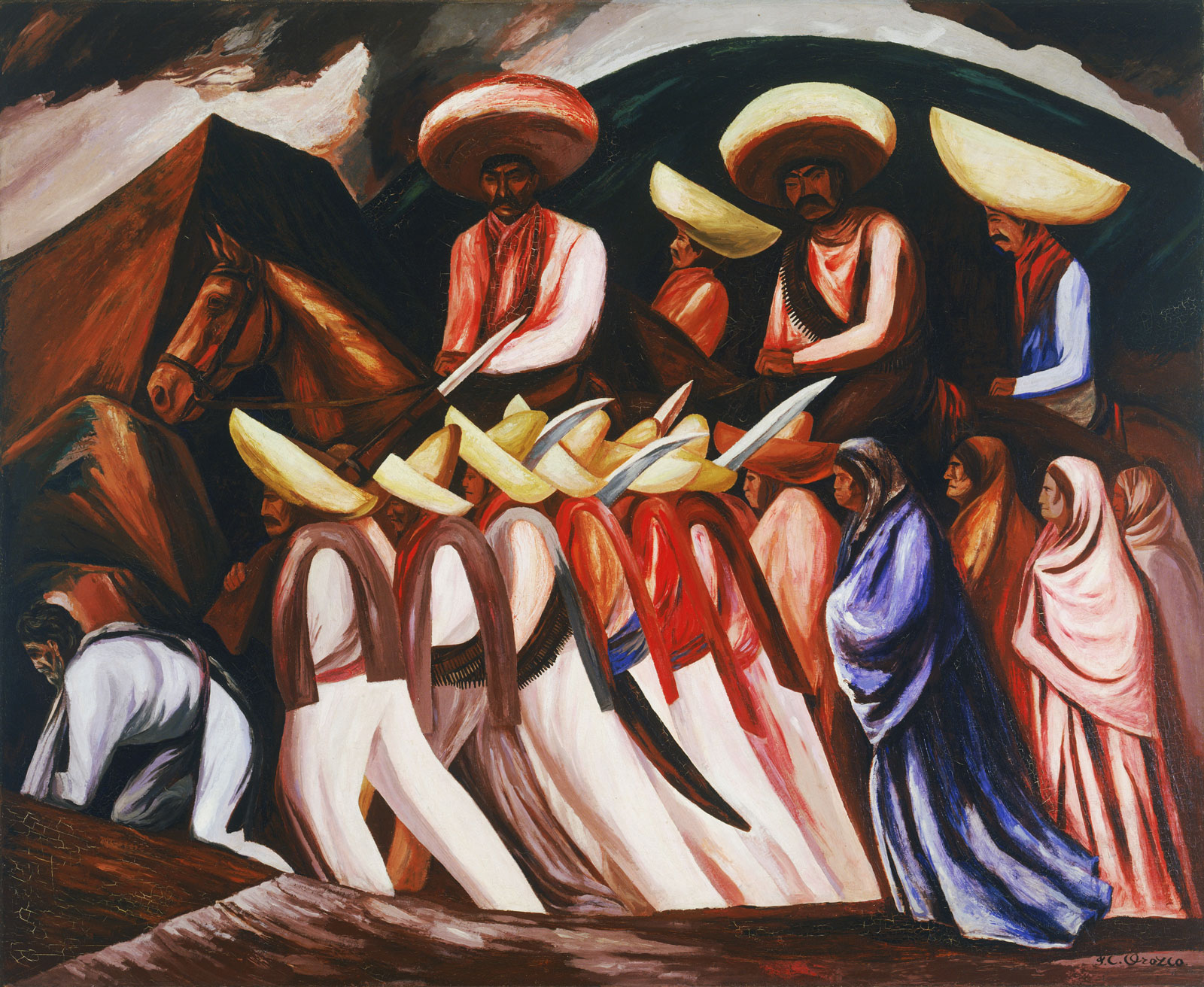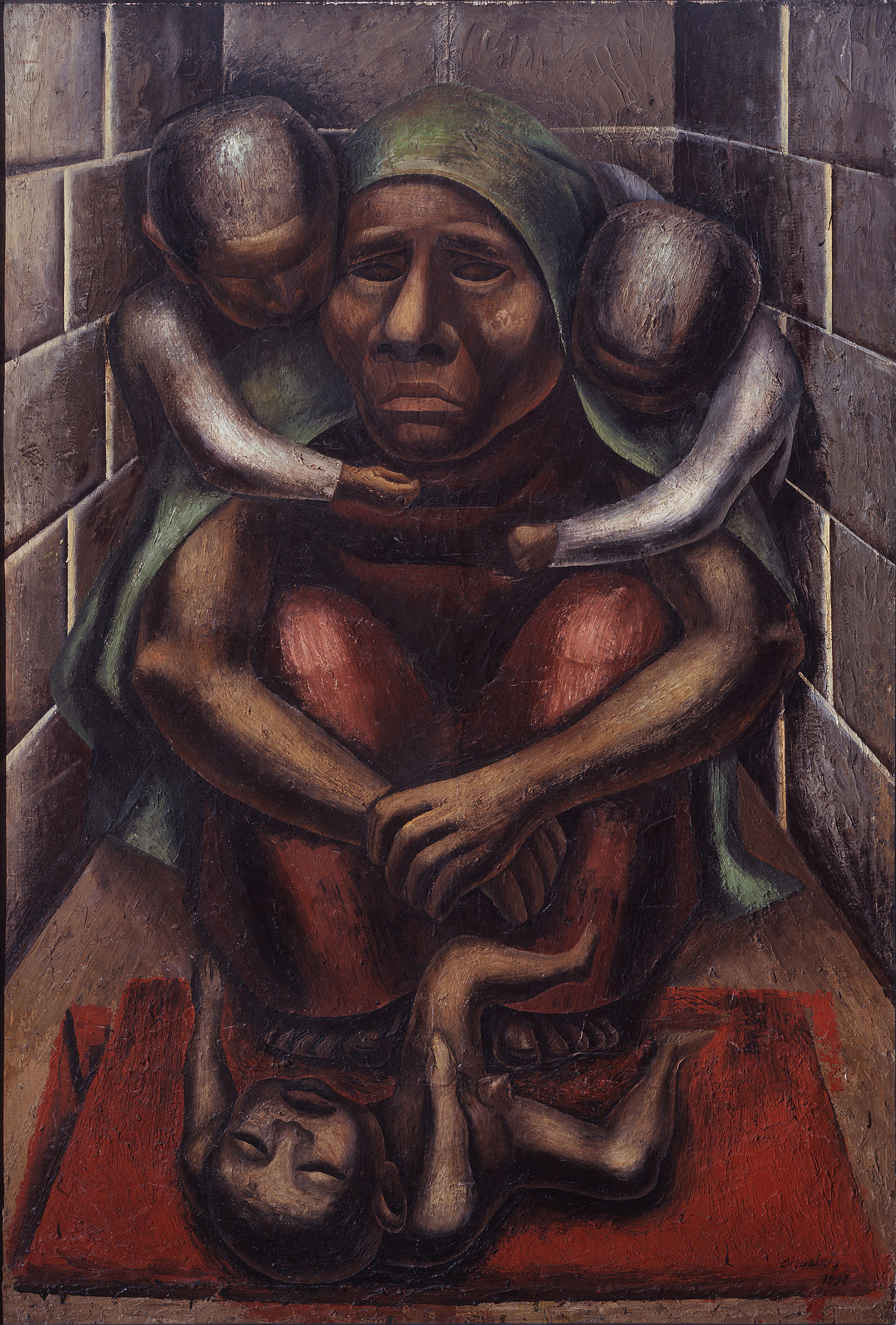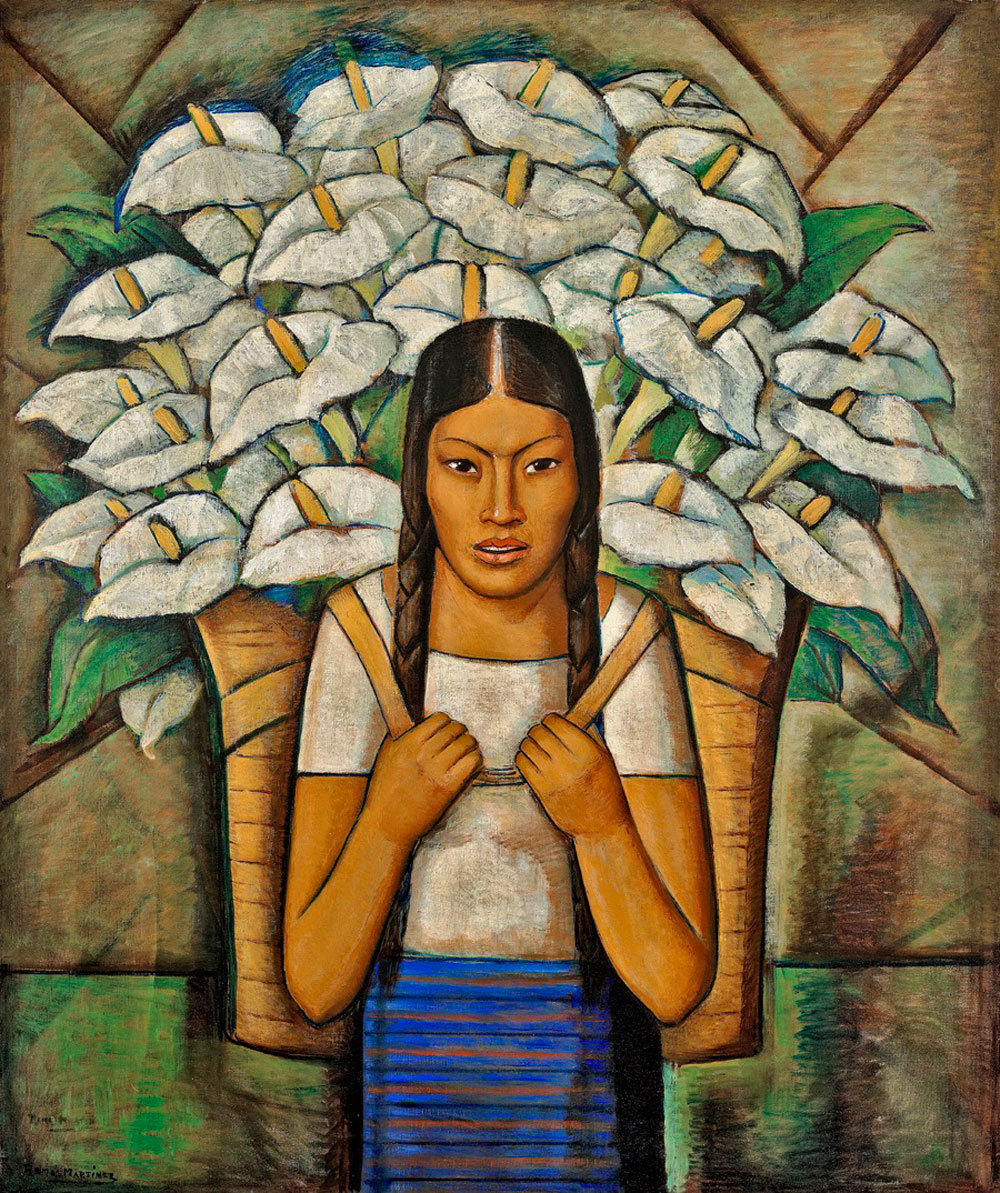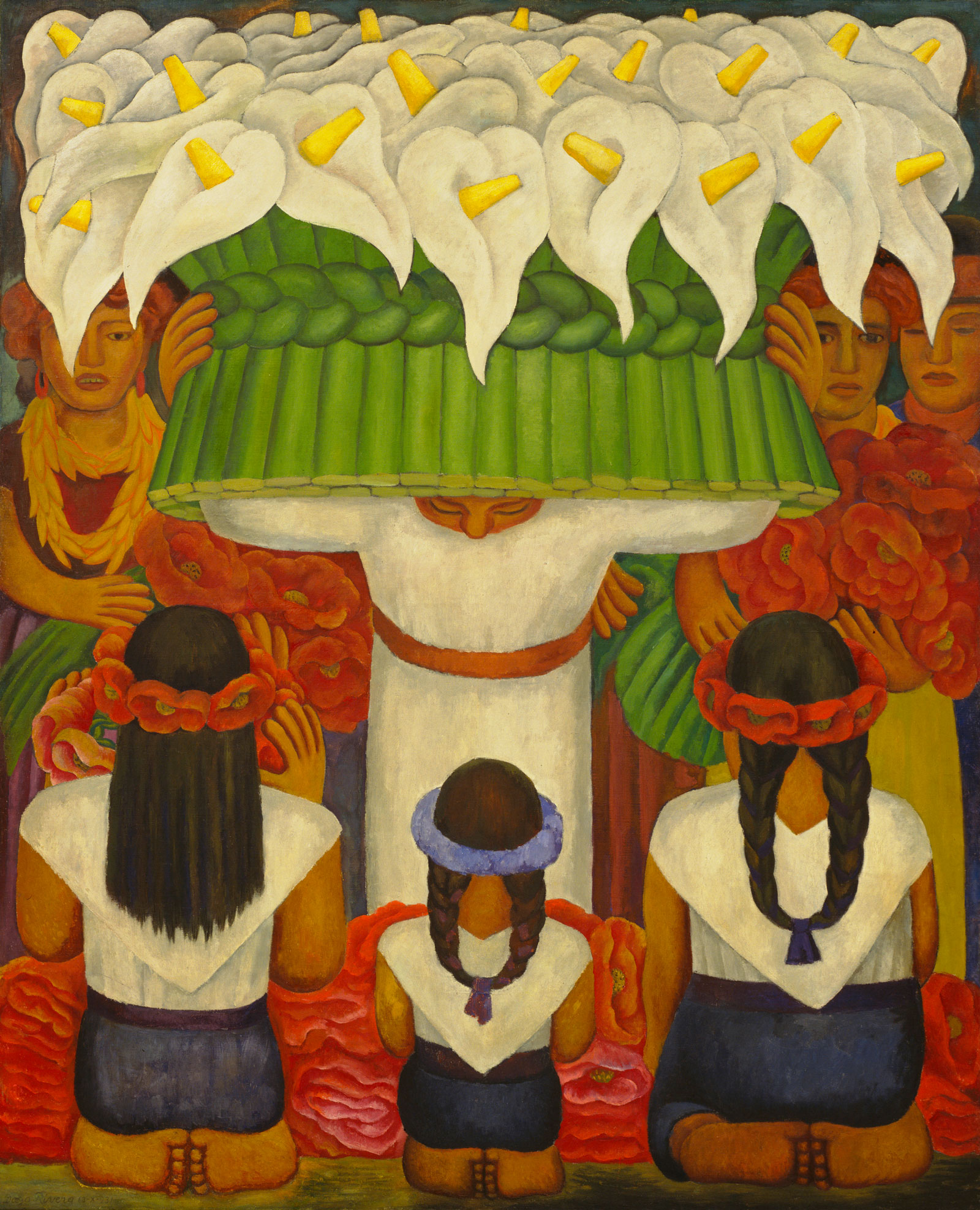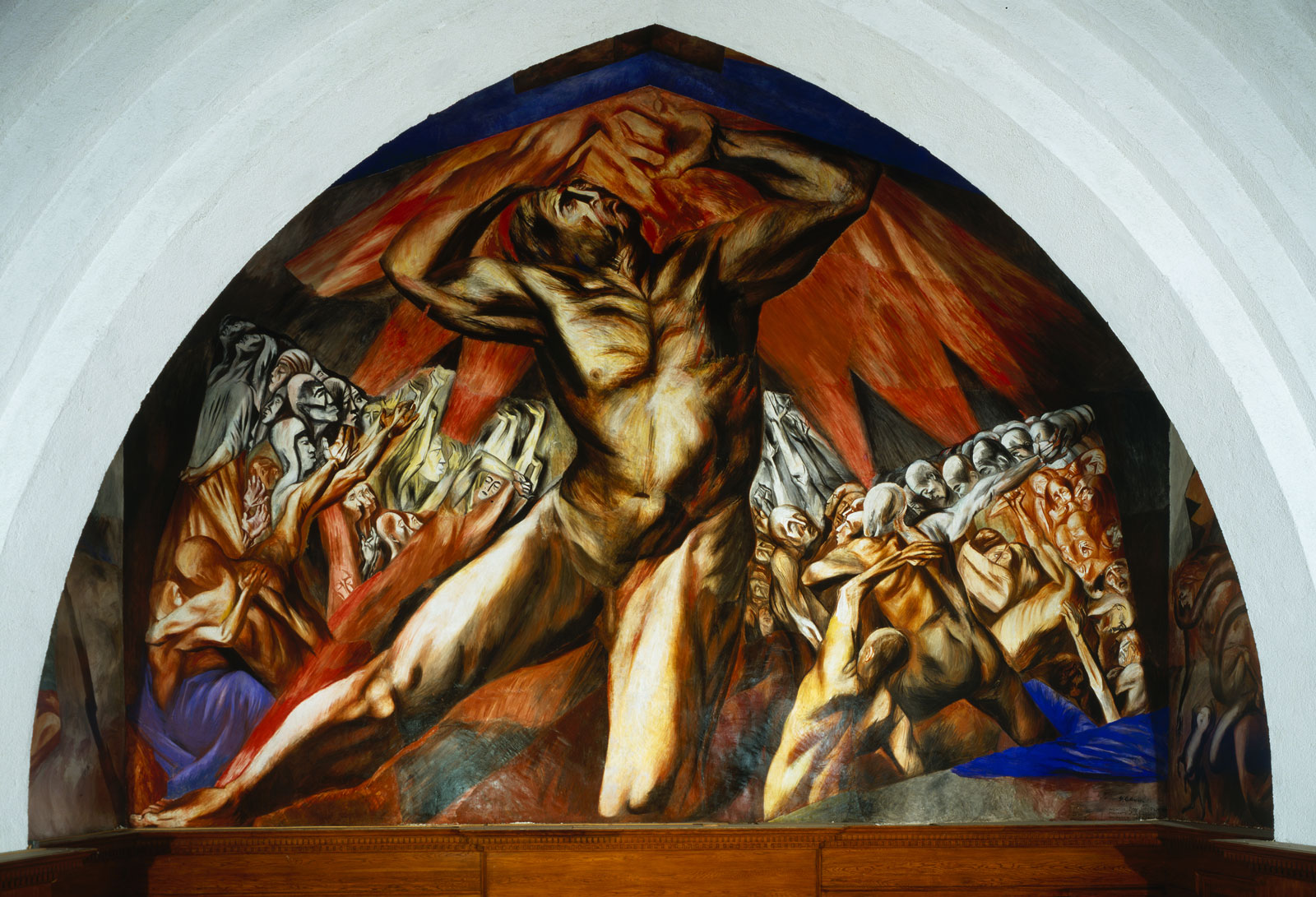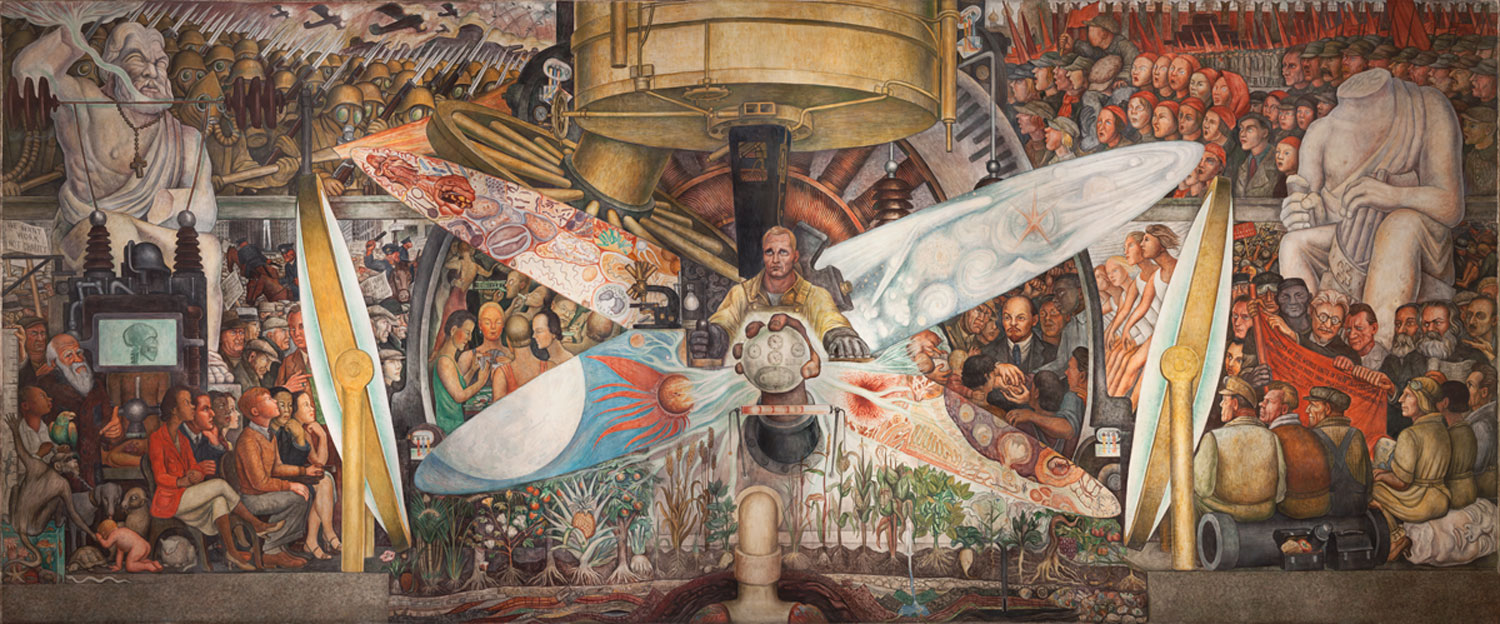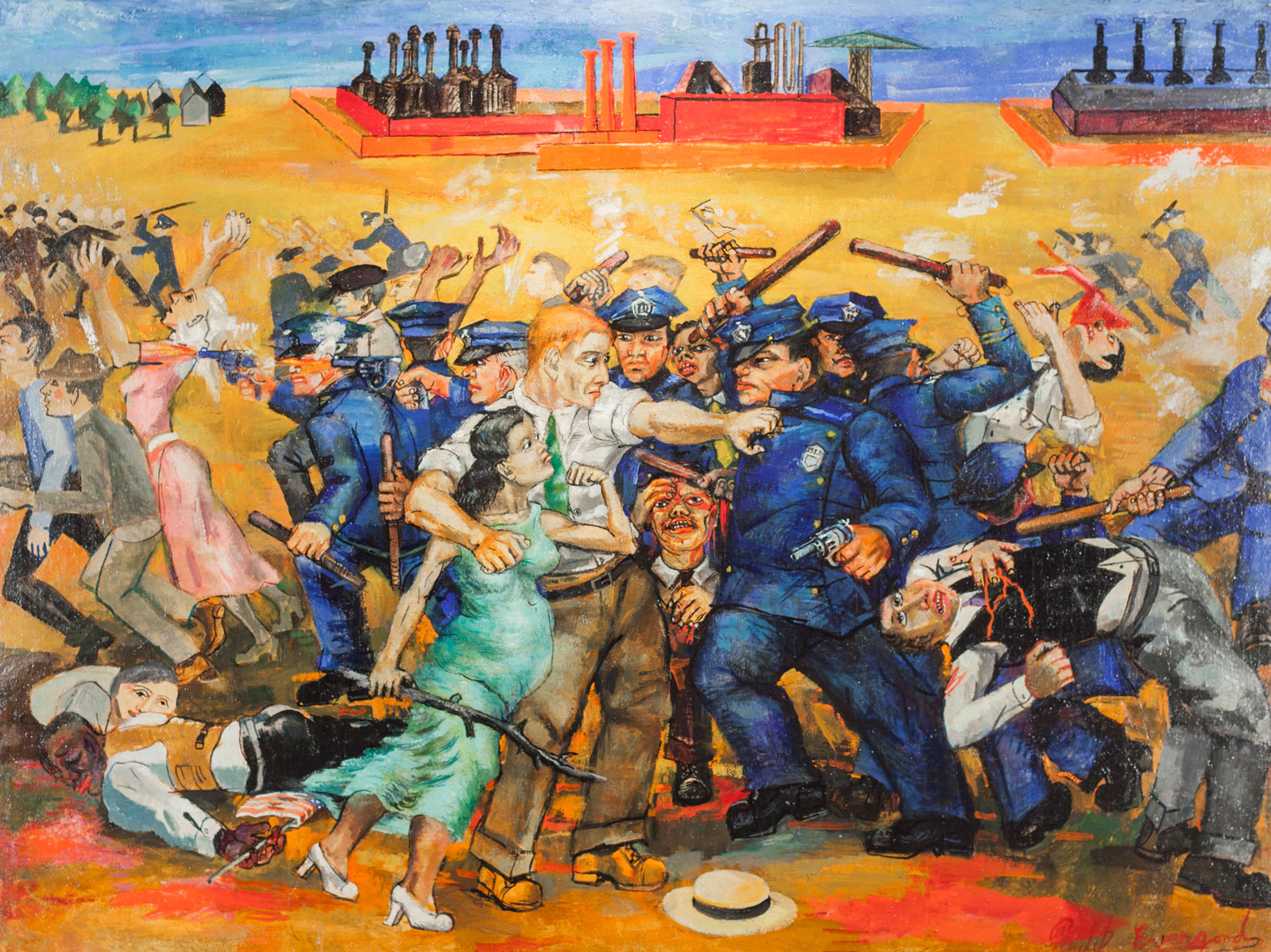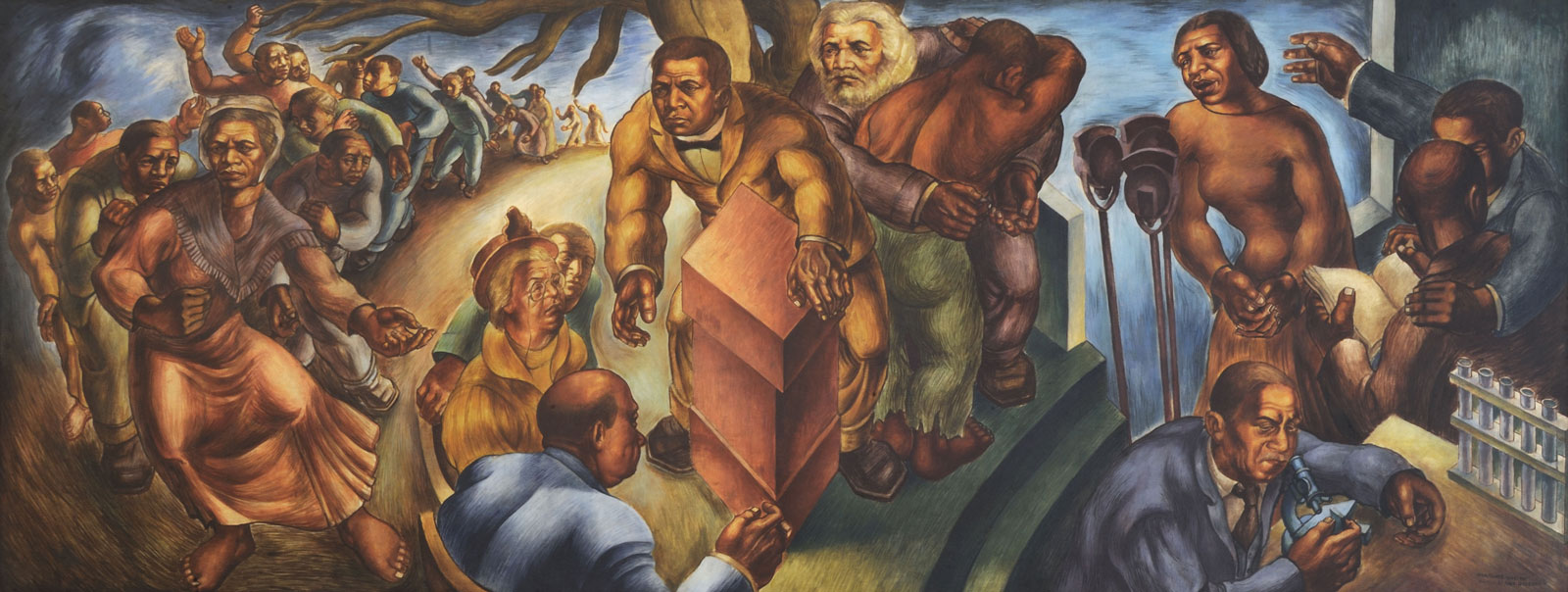The Whitney’s show, “Vida Americana: Mexican Muralists Remake American Art,” is a study in revisionism, recasting the standard story so that those formerly disregarded and excluded from the canon of modern American art are instead given a place in it. Exhibitions in recent years have been doing that rewriting in accord with values newly freed from stigma, discovering or rediscovering artists who are female or non-European-American, or who simply didn’t fit the strictures of formalist Modernism. The artists in this show, however, were truly avant-garde in their social values, championing the underdogs of history when it was deeply unfashionable to do so.
Their politics and style became, in the late 1940s, the subject that dared not speak its name, and they were all but expunged from the record. They were Communists or fellow travelers, and the show could equally have been called “American Communists”: it seems the more apt title for an exhibit less about “American life” than about a sense of what that life ought, and ought not, to be.
Though the show is presented coolly enough as a reassessment of the influence Mexican artists had on North American art, I could not greet it with detachment. The three Mexican muralists central to the show—Diego Rivera, David Alfaro Siqueiros, and José Clemente Orozco—were touchstones for my lefty artist father, who had made the pilgrimage to exotic New Hampshire from New York with a group of friends just to see the 1934 Orozco mural in Dartmouth’s Baker library. A number of my father’s old buddies and teachers from the American Artists School—where a free art education was briefly to be had, between 1936 and 1941, courtesy of the John Reed Club—are in the show.
After enjoying early success, they all led lives of unexpected obscurity. I was painfully exhilarated, and haunted, seeing these household gods, who were blacklisted or simply denigrated during their lifetimes, validated on the walls of the Whitney, now that they are all dead. The show’s labels did not tell this tale. It was as if no one else knew.
That sense of their times and ideals left me feeling that the show—though impressive, beautifully put together, and full of rich works never exhibited together before—was denatured, free-floating. This art had been made in passionate espousal of the poor and downtrodden, and fury at how the powerless are crushed, yet the show distanced these concerns as quaint or merely pretty, as though these frankly propagandistic images, instead of rousing viewers to righteous action, were only entertaining as a curious side note in art history.
Some of the pictures by the American artists depict violent union-busting, yet the show’s vitiation of their political intent seemed all the more ironic for being in the Whitney’s new palace in the glitzified district, whose streets not long ago ran with a green oobleck from the meatpacking that gives the neighborhood its name. Most of those jobs, often black- and Latino-held, got moved out of the city and then automated—no busting required. In that respect, the quaintness played up by “Vida Americana” unwittingly underwrites a view of the artists’ naiveté in their means of confronting power.
*
The show is almost two shows. Murals are touted as the main event, and the work in the US end of the Americas by los tres grandes, the Mexican big three, made its biggest splash in that form. But the exhibit opens with its lushest works, freestanding, in various media, under the rubric “Romantic Nationalism and the Mexican Revolution,” and this is easily the most seductive section. It definitely illustrates la vida Méxicana, in paintings that delight in the patterns and colors, embroidered clothing, and decorated pottery of traditional Mexicans. Two feature calla lilies—Flower Day (1925), by Rivera, and Calla Lily Vendor (1929), by Alfredo Ramos Martínez, carried on the back in vast bundles so that the irresistibly glamorous flowers almost fill the upper frame from edge to edge.
Another by Martínez makes a similar feature of yellow sombreros crowding the painting frame much like earthy version of daffodils, with the occasional brown face or reddish serape and three gray gun barrels that could almost be stems punctuating the field. Despite the ammunition belt decorating a white-shirted chest in the foreground, the faces that are visible appear watchful but also hard to read; the effect is a paradox of attractive, inhabited serenity. I’m not sure I’d guess these were revolutionaries if it weren’t called Zapatistas (circa 1932).
Likewise, it is mainly the title that elucidates a near-life-size line drawing by Rivera, Study for Agrarian Leader Zapata (1931), showing a white horse stepping over a prone body that is easy to miss. Though the horse is led by a man clutching a machete, presumably the leader, the most prominent feature of the work is the eye of the horse, more human than those of any of the men around it, soft and almost flirtatious, like its Veronica Lake mane, as if the creature is swoonily pleased to be recruited by the righteous warrior. Only a couple of paintings in this section, by Orozco—dark and full of slashing diagonals—seem to reflect the violence of the ten-year rebellion against peonage.
Advertisement
What we see of American artists in “Romantic Nationalism” seems far less reflective of politics even than these slightly unreadable paintings. In the Twenties, there was a bohemian embrace and idealization of the folkloric, an inclination paramount in the several black-and-white photographs by Tina Modotti. The images seem meant as proof that, yes, Mexican men really do wear sombreros and serapes, and the women actually carry handsome local pottery on their braid-ornamented heads. A creaky color film intended to promote tourism to Tehuantepec has the same subtext, regarding the native culture as uncorrupted by modernity, though a highly camp version of it. (The voice over a peasant wedding procession chirps, “Some woman’s been lucky enough to find an eligible man.”)
Folkways may have been less central for the harder-core artists who went to Mexico for the socialist politics of its agrarian revolution, but one of the surprises of this section is a clip of Sergei Eisenstein’s ¡Que Viva México! (circa 1930) that makes a gorgeously black-and-white foil for the silly tourist film, presenting another indigenous Tehuantepec couple in their picturesque layers of cotton. It is amusing in quite another way—for how Eisenstein turns the young man and woman into the proletarians of his Soviet movies as he dwells on their shy smiles with multiple back-and-forth reaction shots, as if emotion—even when naked and unguarded—is always ponderous and difficult for audiences to apprehend.
That the Soviet common ground with the Mexican Revolution—an elimination of class privilege—is quite to the point is more evident in other sections, but there is a third movie in this opening one, by Paul Strand. Its images are stark rather than luscious blacks and whites; the dialogue, translated by Leo Hurwitz, later a blacklisted Hollywood writer, says it all: “Poverty is not the law of nature, nor God’s law.” (This friend of a friend of my parents’, and a kindly man, advised me on a screenplay in the Seventies, so it was one of the many instances in the show that to me felt like a reunion of old comrades.)
It is not possible to transport murals and exhibit them on other walls—they’re part of their walls. The Whitney has found ways to recreate or simulate a few of them, including one long unviewable, by Siqueiros. The black-and-white photo of it was a lucky find that has been blown up to wall size; the original, from 1932, depicting the crucifixion of an indigenous man, looming over Los Angeles’s Olvera Street, was whitewashed soon after its creation. (It is now at last undergoing restoration.) Infinitely more successful was the 1930 mural of Prometheus by Orozco, flames licking downward from over the hero’s head toward the human hordes on each side reaching for them. In real life, it looms hugely, above yards-high paneling, over a college dining hall in California; it’s reproduced here complete with the pointed arch in which it resides, but many times smaller than the original, and near eye level.
It’s not clear to me why it was such a sensation, but it seems to have ignited the mural craze in the US. The Mexican muralists had gotten “big” at home by painting big—at the behest of a government that was briefly socialist after fighting ended around 1920. But when commissions in Mexico dried up, the big three came to this country. Their original remit had been to unite their war-torn country, essentially by visually embodying a national myth—a mission that then coincided, in the US, with a rampant desire to make an art that was authentically American, while also putting “the people” into “folk.” This impulse manifested in everything from Copland’s Appalachian Spring or the dance form Martha Graham invented to the revivified traditionalism of Woody Guthrie and Leadbelly; in writing, a sense of American distinctness and originality was celebrated in work as various as that of John Dos Passos, Theodore Dreiser, and Sinclair Lewis. Young American artists, touched by the flame, apprenticed themselves to the visiting Mexican stars—Philip Guston and Fletcher Martin, among others, worked on the Olvera Street mural.
Advertisement
They flocked to Mexico as apprentices as well. The Abelardo L. Rodríguez Market murals in Mexico City were painted by Rivera’s disciples, including the sisters Marion and Grace Greenwood, and Isamu Noguchi is represented by an immense painted bas-relief there. These murals are displayed in the show via panoramic video on three walls in a devoted room. Their subjects are educational, such as “The Industrialization of the Countryside,” and their images action-packed, like Bruegels, but structured by the architecture, and very much part of people’s lives—as backdrop rather than foreground for the shoppers roaming the giant mercado, though clearly some visitors are there just to look. The video zooms out to show the 1934 building against its plaza and then within the city, as if to emphasize the integration of this art with the people and life it valorizes.
Rivera’s fresco at the Palacio de Bellas Artes in Mexico City, Man, Controller of the Universe, is reproduced, quite convincingly, at wall size. It is a stand-in, you could say, for something we should be able to see in New York, where Rivera first painted a version of it in 1933. His style has an atmosphere of calm decency, the figures shallowly but naturalistically modeled, the colors mid-range and blending, so it’s easy to see why he was successful in the US, where he was taken up by inheritors of industrial fortunes like Edsel Ford, for a commission at the Detroit Institute of Arts, and the Rockefellers.
Fellow leftists believed those commissions branded the artist a sellout (as they accused); or it may have been Rivera’s friendship with Stalin’s declared enemy, Trotsky; or—shocking idea—it could have been professional jealousy. Whichever it was, the indirect result was that he, and we, lost the mural done for Rockefeller Center. To prove himself still a man of the left, Rivera stuck a very obvious portrait of Lenin into the work. Because of it, as soon as the artist left town, the mural was hidden under drapery, then destroyed. In the end, Rivera did get to use some of the Rockefeller mural’s architecture and its central propeller motif—which makes the Controller of the Universe look as if he has dragonfly wings, in the Mexico City fresco—Lenin and all.
*
Most of the art made by the US denizens shown here is small, often black-and-white graphics, the greatest exception being a broad selection of panels from Thomas Hart Benton’s wall composition American Historical Epic (1919–1928). The closest thing to a mural by a North American in the show, it honors the people living in this country before European settlers arrived (as do the Mexican works) and shows the settlers as invaders. Though Benton didn’t share the leftist politics and hewed to his own idiom, he too had worked with Siqueiros.
Among the smaller works, it was old home week for me. One of my father’s old associates was William Gropper, represented by a drawing of a striker and a small oil, Youngstown Strike (1937); I don’t need to tell you how well the strike is going. Hugo Gellert, too: large tempera image, capitalists with moneybags and an evil policeman (the left was never in doubt about the object of police protection: property, not people). And here was “Ref,” Anton Refregier, with a modest study of a white mob yanking Chinese San Franciscans by their queues, this one wrenching sketch standing in for his extensive WPA Post Office mural near the Embarcadero… As a girl, I was impressed that the Refregiers could eat free at the popular Cookery in Greenwich Village, where Ref’s Calder-like sculptures made of kitchen implements adorned the walls, courtesy of legendary lefty jazz impresario Barney Josephson.
I was excited to see graphics by Harry Sternberg; my mother had studied with the then well-known Social Realist, but in all this time I’d never seen his work displayed anywhere. Industrial Landscape (1934) is typical of his work’s affect: a lithograph showing a strike scene, in which a man is bayoneted by a well-armed thug in helmet and gas mask, while a woman dashes forward with her hand out to prevent the carnage; behind, an army of helmeted men with bayonets confronts a group of workers in overalls with mere sticks, against the background of a factory building, identified by its smokestacks. As with much US work here, the subject is violence—violence directed against the poor and powerless, the indigenous, and people of color, who can’t protect themselves or effectually fight back.
That’s the social part of Social Realism, but the style itself could be found in apolitical work—the grayscale and simplifications of form in a print of a rural scene by Victoria Hutson Huntley, say. It was all over illustration in this period, a time when illustration was ubiquitous. Which was perhaps one reason that saying an artwork was like “illustration” in the Sixties was to cast it into outer darkness. If there was a flaw in the beliefs of these Social Realists of my parents’ generation, it was that art should convey blunt messages. All the political work here, regardless of scale, is illustrative—intentionally so. It can be beautiful, but illustration rarely shimmers with ambiguity, ironic layering, or depth at all: it intends not to have double meanings.
You can also see a stylistic affinity in these political works with early Hopper or his painting companion Guy Pène du Bois, and the Ashcan School painters. The famous Mexicans, for their part, may have had a huge effect on the ambitions and scope of the Americans but, as to style, because the Mexican painters are so different from each other, and the American artists mostly strove to find their own ways of working, any effect is less clear. This is true even in the case conspicuously, and fascinatingly, highlighted by the show: the possible genesis of Jackson Pollock’s drip method in a workshop given by Siqueiros, in which Siqueiros had canvas nailed to the floor. But what Pollock ultimately did with it was all his own.
As for subject matter, the worker hero was a mainstream trope in the Depression. For the political artists, this was a message also reinforced by Soviet sources. If the Whitney is rewriting the story of American art history of the last seventy or so years, I am not convinced that this chapter excludes European influence in favor of Mexican, as touted by the show’s organizer, Barbara Haskell, though all kudos to her for the huge work of putting this together. The Mexicans themselves were using European media and techniques; it was said of Rivera that while he “never believed in God, he did believe in Picasso” (another Communist, among much else). The artists of this period were trying to make something modern but accessible to “the people” because they were socialists, and culturally “national” because of the times. But the wish to self-consciously invent a national idiom in the arts, whether in the US or Mexico (or in Bohemia through use, by Antonin Dvorák, for that matter, of folk tunes), has probably always been a chimera.
The wall of Jacob Lawrence’s Great Migration paintings, synthesizing or transcending those concerns, towers here, strikingly free of both social and visual clichés. Color defines the forms and patterning of this epic story told in tiny scenes. But it is also notable how no one in the show worried about appropriation: all oppression was their oppression. Paintings by Eitarō Ishigaki illustrate injustices to African Americans, as do portrayals of lynching by Noguchi; male artist Mardonio Magaña sculpts a Käthe Kollwitz–like woman and child. They took the universality of sympathetic emotion as given.
The business of pinning down influences is a mug’s game, especially to an arts practitioner: you grab from anywhere and anyone, whatever suits the occasion. Rivera looked to Picasso; today, an Afropop artist cites Muddy Waters as his inspiration. The entire loosening up of the canon after the years of formalist orthodoxy is in part a reaction against the very idea of influence—T.S. Eliot, in “Tradition and the Individual Talent,” begat Clement Greenberg, who begat a theory of artistic progression modeled on Hegel (and, ironically, Marx), whereby curators sought anointed scions in the line of descent and artists strove to be “onlie begetters.” Those essays were an influence, and a theory of influence, that funneled American art into a narrow stream, or intended to.
You could say it was the very idea of influence—the hope of having it, politically—that generated CIA and the US Information Agency’s covert campaign for the primacy of Abstract Expressionism during the cold war, which greatly helped to make that aesthetic the dominant and even quelling style of work in a time when anything touched by the left or leftism was viewed as aid to the enemy. The USSR remains the invisible elephant in the show’s exhibition rooms.
For me, seeing so many familiar, all-but-forgotten names was like confirmation that our household gods really did exist, that I hadn’t just imagined their significance to an outside world. Now that the pandemic has closed all museums, Vida Americana’s excellent catalogue may be as much as people get to see of this magnificent coming together for the time being. At least the US Post Office has caught up with its own period riches, issuing a set of “Post Office Murals” letter stamps.
Murals, an undoubted legacy of the left, still sprout in certain neighborhoods, replete with icons of social issues or community figures, whether George Floyd or Che. Like the artworks painted on walls in Vida Americana, these non-art-world expressions are like the bouquets still daily laid on Marx’s grave in Highgate Cemetery, tributes to thwarted hopes, and proof of hope ongoing.
“Vida Americana: Mexican Muralists Remake American Art, 1925–1945” will be rescheduled at the Whitney Museum, with dates to be announced.


